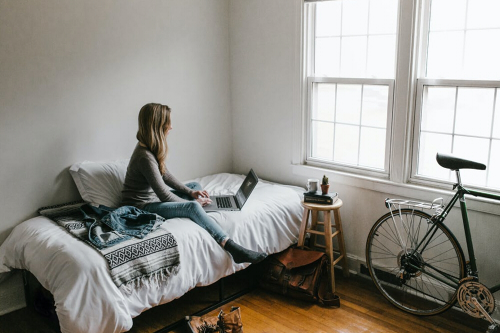Offices in 2050: Smart, Interactive and Fully Personalised
2050年办公室:智能、交互、完全个性化
An article in Time magazine, published in 2000, depicted a futuristic white-collar worker who would find jobs “on the web” to do at home. She would work with “a far-flung virtual stable of teammates”, while “her fully wired home is her castle”.
《时代》周刊2000年发表的一篇文章刻画了一个带有前瞻性的白领,她会“在网上”找工作,在家办公。她会与“一帮天各一方、虚无缥缈的团队伙伴”一同工作,而“全面联网的家就是她的城堡”。
Yet almost 20 years later, workers worldwide still flock to offices each day. The percentage of US employees who work from home increased from 3.3 per cent in 2000 to 5.2 per cent in 2017, census data show – leaving almost 95 per cent still travelling to work.
可是近20年过后,世界各地的工作者仍每天涌向办公室。普查数据显示,在家办公的美国雇员比例从2000年的3.3%增加到2017年的5.2%——近95%的人还是要出门上班。
While few now doubt that offices will exist in 2050, digital and cultural shifts are fast changing the fabric of the office.
现在几乎没人怀疑2050年时办公室会依然存在,不过数字和文化变迁正在迅速改变办公场所的构造。
“We don’t have to go to work to work. I’ll go to the office when I want to support my sense of belonging, of community,” says Despina Katsikakis, head of occupier business performance at property agent Cushman & Wakefield.
房地产经纪公司高纬物业咨询公司租户经营业绩部门负责人德斯皮娜·卡齐卡基斯说:“我们不必为了工作而去上班。我会在自己想要强化归属感和社群感时去办公室。”
This will bring “reconfigurability” to the office, which is different from the standardisation we see today. Ranks of desks in open spaces are already giving way to features that enable the environment to adapt to workers’ needs. Shared office groups such as Knotel offer moveable furniture, including phone booths and modular walls.
这会赋予办公场所“可重构性”,它有别于我们今天看到的千篇一律。开放空间成排的办公桌已经在让位于使环境适应工作者需求的特征。科诺特尔公司等共享办公企业提供可移动家具,包括电话亭和模块化墙体。
Smartphones can make this personalisation even more granular, adapting work spaces to each individual. Connected buildings learn how a worker uses them and will tailor the air, light, desks – even the coffee – to each member of staff.
智能手机可以让这种个性化更加细化,让工作空间适合每一个人。联网建筑了解工作者使用它们的方式,会为每位员工量身订制空气、光线、办公桌——甚至咖啡。

Edge Technologies, a Dutch property developer, claims to have “made a computer out of a building”. Workers at Deloitte, a tenant in an Edge building in Amsterdam, have a smartphone app that will find them a car parking space (if they need one) and desks, and adjusts the environment to suit individuals.
荷兰房地产开发企业埃奇技术公司声称“用建筑造出了电脑”。德勤公司在阿姆斯特丹租用了埃奇公司的办公楼,德勤的员工有一款智能手机应用可以帮他们找到停车位(如果需要的话)和办公桌,还会调节环境来适应个人需求。
While much of this technology already exists, the pace of innovation will accelerate over the next 20 years, says Guy Grainger, chief executive for Europe, Middle East and Africa for JLL, the property consultants. “The speed at which workplaces will change is correlated with the speed of our adoption of new technologies and ways of working. The next generation [of workers] are digital natives and they’re a different animal,” he says.
房地产咨询公司仲量联行的欧洲、中东和非洲区总裁盖伊·格兰杰说,这些技术大多已经存在,不过今后20年,创新的步伐会加快。他说:“工作场所改变的速度与我们采用新技术和新工作方式的速度相互关联。下一代(工作者)是数字原住民,他们是另一种生物。”
Tech developments will enhance the tools available to office workers. Seamless virtual meetings with real-time language translation will become routine and replace the awkward conference call, says Ms Katsikakis.
技术发展会增加可供办公场所工作人员使用的工具。卡齐卡基斯说,采用实时语言翻译的无缝衔接虚拟会议会成为常态,取代费事的电话会议。
Glass installed in buildings by View, a Californian company that makes “intelligent” windows, already adjusts its tinting to alter heat and light levels. The company is also developing sensors to warn of intruders and windows that turn into interactive screens, says Jeff Platon, a vice-president.
加利福尼亚州“智能”窗户生产企业“视野”公司生产的建筑安装玻璃已经可以调节色调来改变光热水平。公司副总裁杰夫·普拉顿说,“视野”公司还在研发能提醒有人闯入的传感器和能够变成交互式屏幕的窗户。
Staircases, once tucked into the corners of buildings, are increasingly built as centrepieces to encourage activity and connection, while canteens and breakout areas have gained prominence.
楼梯过去都是隐蔽在建筑物的角落里,如今则越来越多地建在核心位置,以便鼓励人们活动起来并相互沟通,与此同时,就餐区和茶歇区变得突出。
Desks will still be a feature of offices but chairs could vanish thanks to an awareness of the risks of a sedentary lifestyle, according to Mr Grainger. He suggests standing desks will be the main fixtures, alongside a few benches.
格兰杰认为,办公桌仍将是办公室的一个特色,不过由于人们意识到久坐不动的生活方式具有风险,椅子可能会消失。他表示,站立式办公桌将是主要固定设施,外加几张长椅。
In this quest for smart offices, workers will have to sacrifice some norms – including space and their own desks.
在追求办公场所智能化的过程中,工作者不得不牺牲一些习以为常的东西——包括空间和属于自己的办公桌。
Privacy may also suffer. Sensors that track movement and the use of office facilities are already common – following individual workers is becoming more so.
隐私可能也会受到损害。追踪人员移动和办公设施使用情况的传感器已经很常见——关注单个员工的一举一动变得更加普遍。
The high-tech offices of 2050 will not be for everyone, however. In fact, the number of people with the right to work in such smart spaces may diminish with the growth of the freelance and gig economies.
不过,2050年的高科技办公室不会面向所有人。事实上,随着自由职业者和零工经济的增多,可以在这种智能空间工作的人数或许会减少。
英文、中文版本下载:http://www.yingyushijie.com/shop/source/detail/id/2444.html








